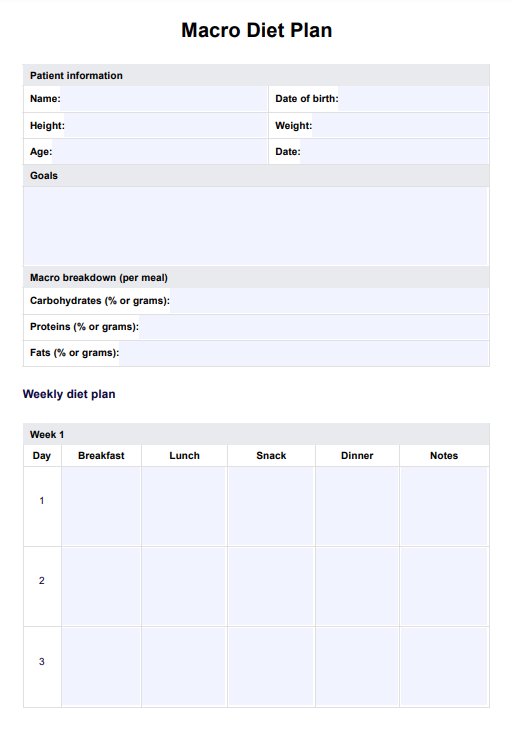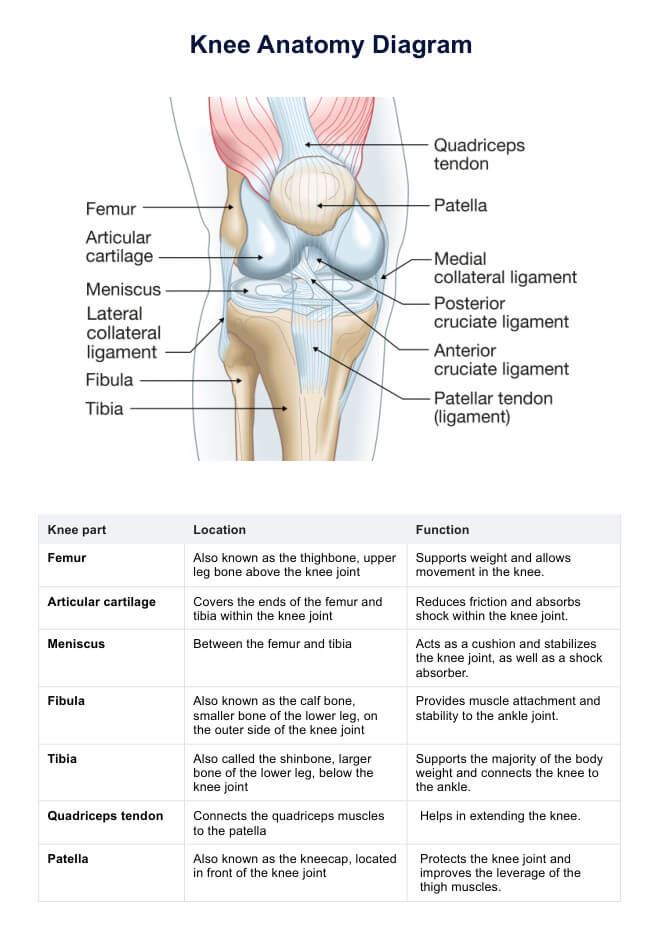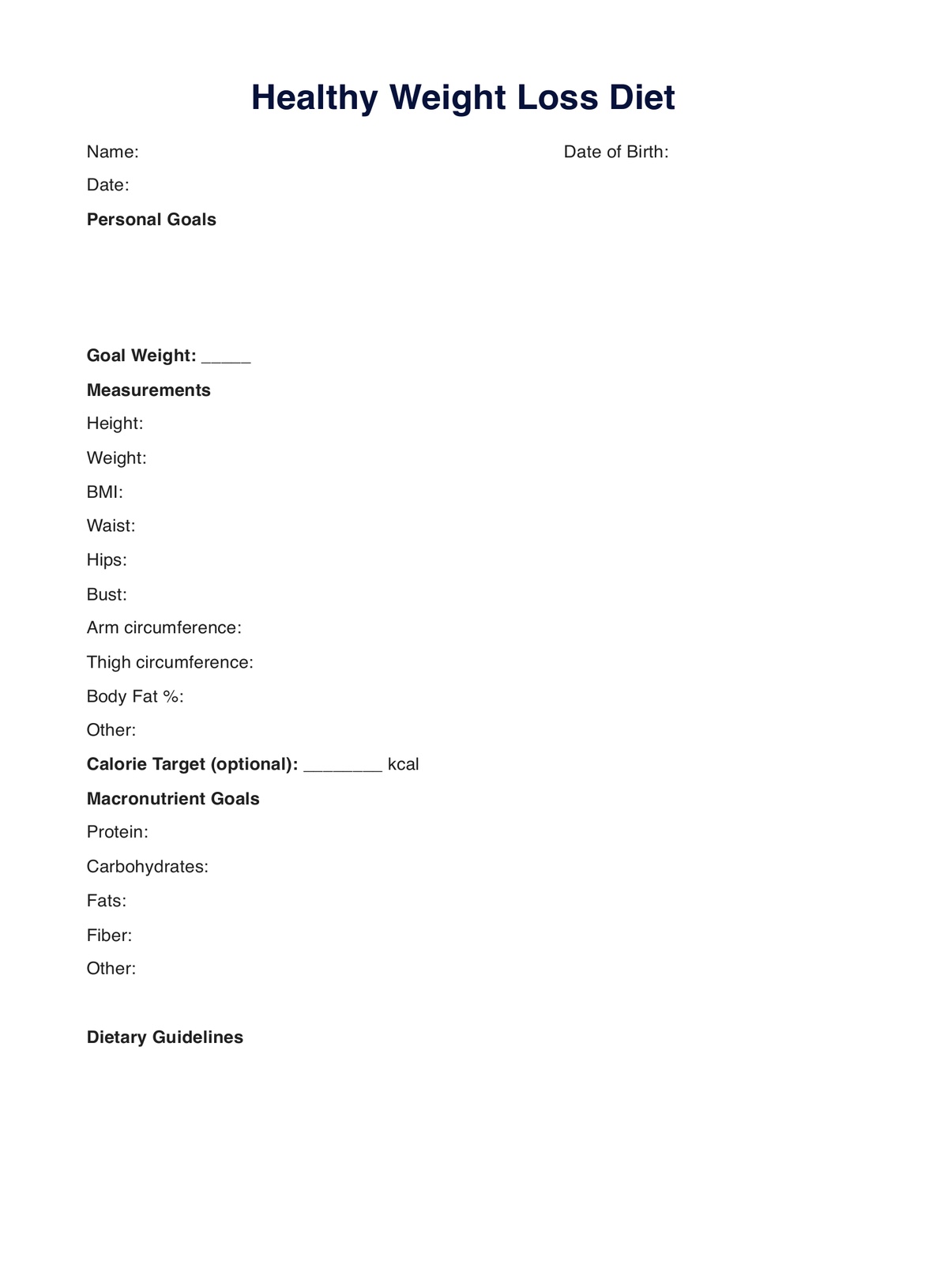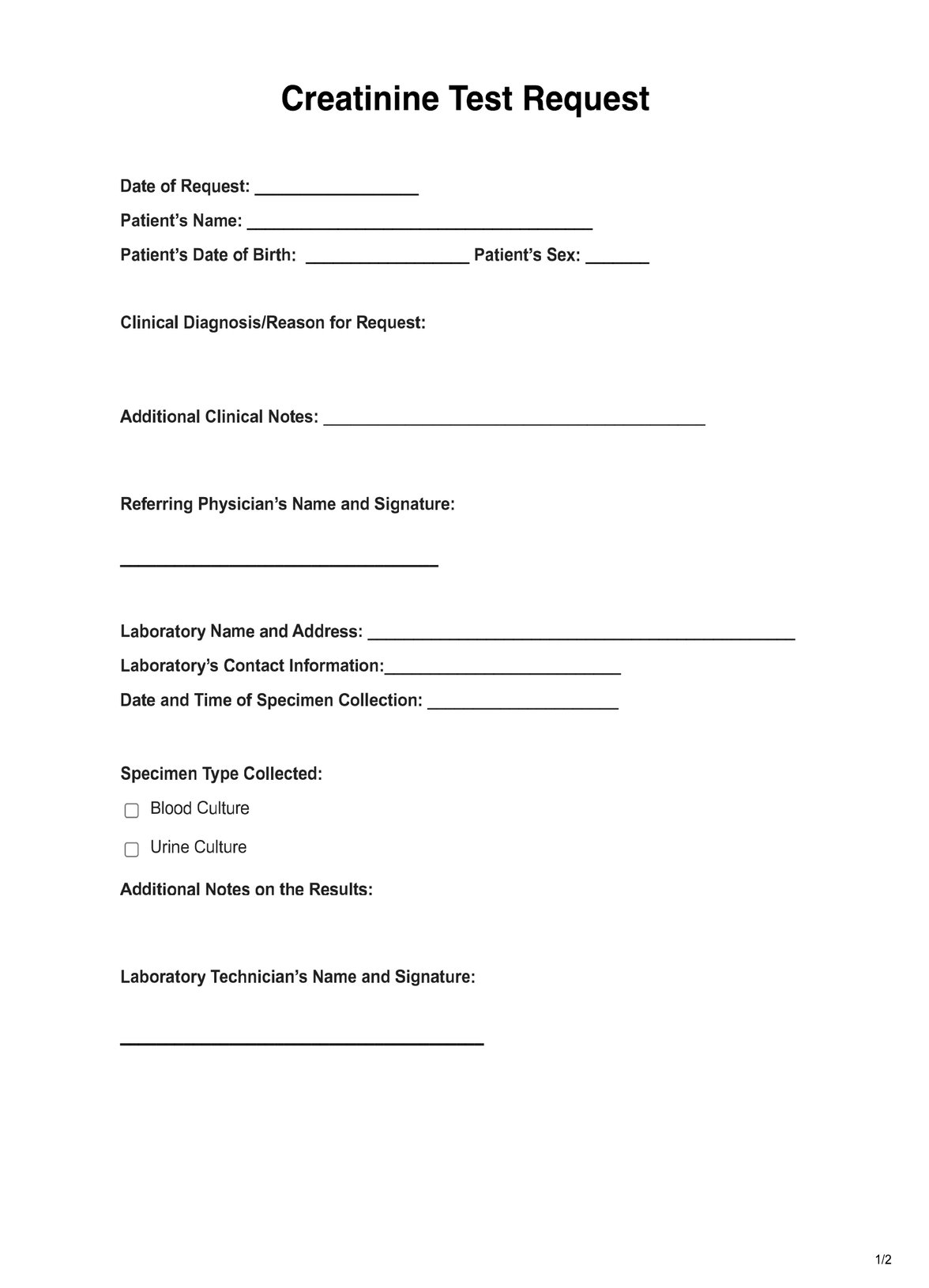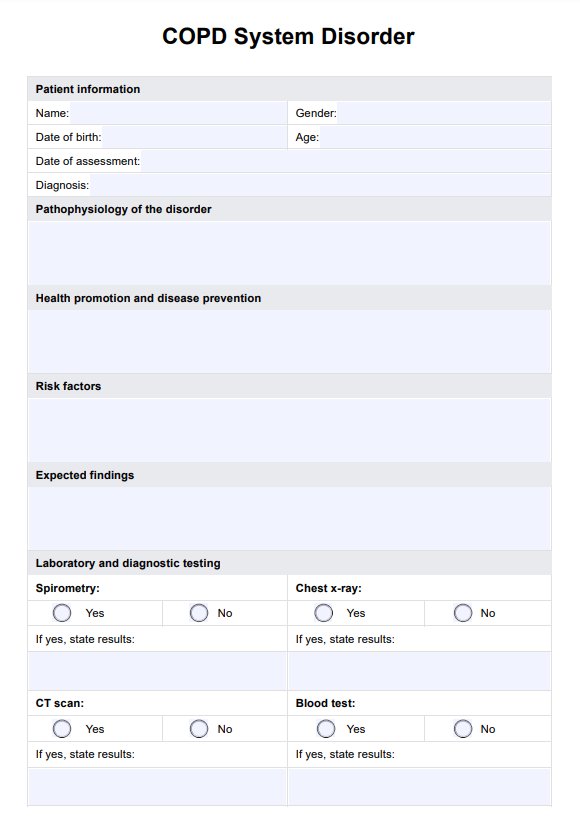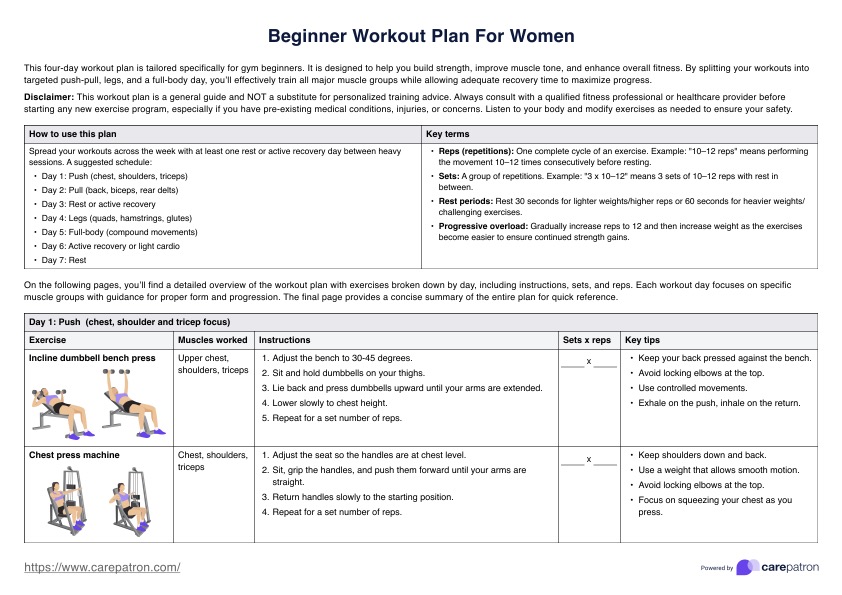Macro Diet
Discover a comprehensive Macro Diet Plan with Carepatron's free PDF download example that can help your patients achieve their health and fitness goals.


What is a macro diet?
A macro diet focuses on tracking macronutrient intake—proteins, carbohydrates, and healthy fats—rather than just counting calories (Ibitoye, 2024). Each macronutrient provides essential energy, with proteins offering 4 calories per gram, carbohydrates 4 calories per gram, and fats 9 calories per gram. The diet divides daily calorie needs into specific proportions, such as 10–35% proteins, 20–35% fats, and 45–65% carbohydrates, tailored to an individual's health and fitness goals (Akers, 2024).
By monitoring macronutrient intake, individuals can align their eating habits with their objectives, such as weight loss, building muscle, or stabilizing blood sugar. A macro diet emphasizes healthy whole foods, encouraging balanced macro meals that support optimal body weight and energy levels. While effective for some, counting macros can be time-intensive and require consistent effort. Despite this, it is a widely used approach for those seeking precision in their dietary habits.
Macro Diet Template
Macro Diet Example
What is a Macro Diet Plan?
A Macro Diet Plan is a structured approach to meal planning that focuses on tracking the intake of macronutrients—proteins, fats, and carbohydrates—rather than just counting calories. This diet aims to help individuals achieve their health and fitness goals, such as weight loss, muscle mass gain, or maintaining a balanced diet, by focusing on the nutritional quality of food. Unlike traditional calorie counting, which only measures the energy content of food, a macro meal plan considers how certain foods impact metabolic rate, hunger levels, and overall health.
Macro meal planning involves calculating a macronutrient ratio that aligns with personal goals, such as how many grams of protein, fats, and carbs are needed daily. A key part of this plan is tracking macros, ensuring that each meal fits the prescribed macro targets. For example, some people may thrive on a higher protein intake, while others may benefit from more carbohydrates. This flexibility makes the macro diet adaptable to different dietary needs.
Meal prep and planning are crucial to success on a macro diet. By preparing meals in advance, individuals can ensure that they stay on track with their macro targets. This strategy supports a healthy lifestyle and helps manage food portions and avoid unhealthy food choices.
Foods to include
When following a Macro Diet Plan, it’s essential to focus on whole, nutrient-dense foods and various food groups such as lean proteins, whole grains, healthy fats, and vegetables. Foods like brown rice, chicken breast, and fish provide ample protein and carbohydrates, helping patients meet their daily macro goals.
Healthy fats like fatty fish, avocado, and olive oil support overall health while contributing to a specific calorie range. To ensure patients get enough protein, they can also consider adding protein shakes to their routine for muscle gain and weight management. These food choices offer essential amino acids, supporting muscle repair and growth.
Foods to avoid
To lose weight and support a healthy body, it is important to avoid highly processed foods high in refined sugars and unhealthy fats. Foods like sugary snacks, fried items, and processed meats contain high levels of saturated fat, which can negatively impact patients' health. These foods often disrupt calorie intake balance, making it harder to meet one's macronutrient ratio.
Instead, it's important to focus on whole foods that offer health benefits and help patients stay within their calorie range. Avoiding these unhealthy options can help them stay on track with their macro meal plans for muscle gain or weight management.
How does it work?
Carepatron’s Macro Diet Plan template is a comprehensive tool that healthcare professionals can use to guide patients in reaching their fitness goals. The following steps outline how to effectively use the template to create a personalized Macro Diet Plan for each patient.
Step 1: Access the diet plan template
To get started, click "Use template" within the Carepatron app. This will open the Macro Diet Plan template, which you can customize by adding specific details about your patient’s profile, including their goals and macronutrient needs. Once customized, you can print or save the plan for further use.
Step 2: Introduce the diet plan to the patient
After accessing and customizing the plan, introduce it to the patient. Discuss their health goals and how following the macro diet can help them manage weight, build muscle, or maintain a balanced diet. Ensure they track their macronutrient intake and follow the meal plans.
Step 3: Discuss meal prep and goals with the patient
Help your patient understand the importance of meal prep and how it ties into achieving their goals. Discuss the macronutrient breakdown and guide them on planning meals around their specific calorie and macronutrient targets. Offer practical tips for meal preparation and balancing food groups.
Step 4: Provide further patient education and next steps
Provide the patient with additional education on maintaining a balanced diet, tracking macros, and adjusting the plan as needed. Encourage them to stick to their meal plan and re-assess progress regularly. Offer ongoing support and discuss any changes in their diet plan based on their results and feedback.
Benefits of using this diet plan
Using a Macro Diet Plan offers several key benefits for those seeking specific health and fitness goals. It helps individuals effectively track macros by counting macronutrients and provides a clear approach to managing calorie intake. This can be particularly helpful for those seeking to burn fat, gain weight, or improve overall health. The Macro Diet Plan encourages healthier eating by incorporating macro-friendly recipes and offering the flexibility to use a patient's own recipes.
Additionally, it provides clear guidance on the necessary amounts of protein, such as through protein shakes, to meet daily requirements. For individuals recovering from eating disorders, it provides a structured approach to balanced eating. A registered dietitian can also use this diet plan to monitor progress and meet nutritional needs.
References
Akers, A. S. (2024, January 30). What is a macro diet, and how does it work? MedicalNewsToday. https://www.medicalnewstoday.com/articles/macro-diet
Ibitoye, T. (2024, January 4). What is the macro diet? Good Food. https://www.bbcgoodfood.com/health/special-diets/what-is-the-macro-diet
Commonly asked questions
The best macro diet for weight loss focuses on a balanced macronutrient ratio while maintaining a calorie deficit. A common approach emphasizes higher protein intake and moderate fats and carbohydrates to support fat loss and preserve muscle mass.
On a macro diet, avoiding foods high in refined sugars, processed snacks, and unhealthy fats is best. These foods can hinder weight management and provide minimal health benefits compared to nutrient-dense options.
Macro-friendly foods include lean proteins like chicken, turkey, and fish, whole grains, healthy fats such as avocado and olive oil, and vegetables like broccoli and spinach. These nutrient-dense foods support a balanced intake of carbohydrates, proteins, and fats.
A 50-30-20 macros meal plan divides daily caloric intake into 50% carbohydrates, 30% protein, and 20% fat. This ratio promotes energy and muscle building by monitoring how many calories they take while supporting a balanced diet.


